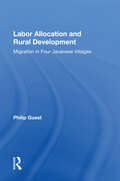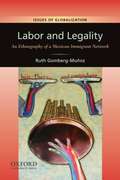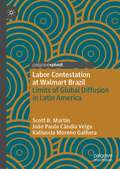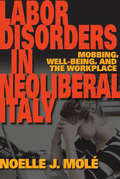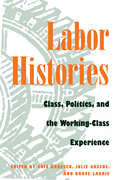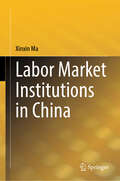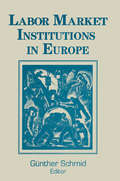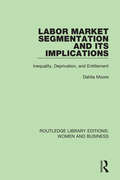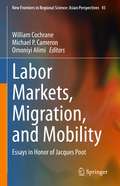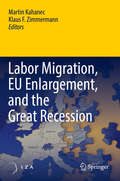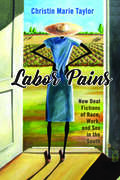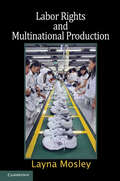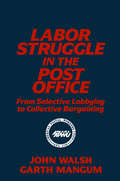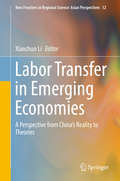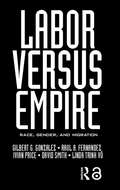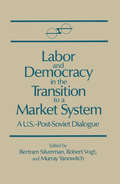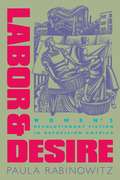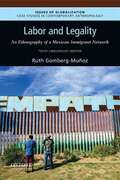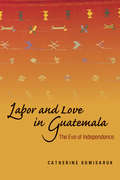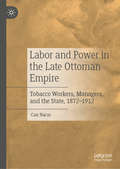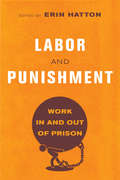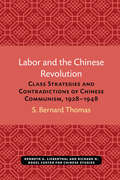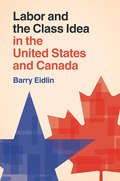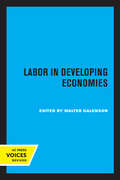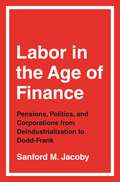- Table View
- List View
Labor Allocation And Rural Development: Migration In Four Javanese Villages
by Philip GuestBy integrating migration research in a comprehensive framework of labour allocation at household and village levels, this study shows how migration factors are crucial in understanding the transformations of rural communities in developing countries. Data collected in 4 villages within a wet rice-growing area of Central Java, Indonesia, are used to examine why some villages and households contribute a greater share of migrants than others. The decision to migrate is located within the constraints and opportunities of local labour markets, and migration is treated as one among many alternatives for allocating the labour of household members. The type of labour allocation choices made is lined to the demographic structure of households, the social position of the household, and the employment opportunities available within the community. These factors are then related to processes of rural development.
Labor And Legality: An Ethnography Of A Mexican Immigrant Network (Case Studies In Contemporary Anthropology Series)
by Ruth Gomberg-Muñoz<P>Labor and Legality: An Ethnography of a Mexican Immigrant Network is an ethnography of undocumented immigrants who work as busboys at a Chicago-area restaurant. <P>Ruth Gomberg-Muñoz introduces readers to the Lions, ten friends from Mexico committed to improving their fortunes and the lives of their families. <P>Set in and around "Il Vino," a restaurant that could stand in for many places that employ undocumented workers, Labor and Legality reveals the faces behind the war being waged over "illegal aliens" in America. <P>Gomberg-Muñoz focuses on how undocumented workers develop a wide range of social strategies to cultivate financial security, nurture emotional well-being, and promote their dignity and self-esteem. <P>She also reviews the political and historical circumstances of undocumented migration, with an emphasis on post-1970 socioeconomic and political conditions in the United States and Mexico.
Labor Contestation at Walmart Brazil: Limits of Global Diffusion in Latin America (Governance, Development, and Social Inclusion in Latin America)
by Scott B. Martin João Paulo Veiga Katiuscia Moreno GalheraThis book explores how and why the labor practices of the world’s largest employer, supermarket giant Walmart, were contested by unions and government regulators as it expanded to Latin America starting in the 1990s. With an in-depth case study of Brazil, and a comparative chapter examining Argentina, Chile, and Mexico, this book analyzes the problematic encounter between diffusion of home-office anti-labor practices and evolving national institutional contexts that are quite varied and in some cases enable considerable resistance by unions and/or regulators. Walmart’s “repressive familial” and “anti-union” model is found to generate costs and conflicts that contributed to its unprofitability and ultimate exit from Brazil in 2018. This experience, contrasted with country situations where Walmart’s overall competitive and labor and human resource practices “fit” better with national markets and institutions, underlines the brittle, problematic nature of diffusionist corporate models lacking adaptive capacity to significant cross-national variations across host countries.
Labor Disorders in Neoliberal Italy
by Noelle J. MoléPsychological harassment at work, or "mobbing," has become a significant public policy issue in Italy and elsewhere in Europe. Mobbing has given rise to specialized counseling clinics, a new field of professional expertise, and new labor laws. For Noelle J. Molé, mobbing is a manifestation of Italy's rapid transition from a highly protectionist to a market-oriented labor regime and a neoliberal state. She analyzes the classification of mobbing as a work-related illness, the deployment of preventive public health programs, the relation of mobbing to gendered work practices, and workers' use of the concept of mobbing to make legal and medical claims, with implications for state policy, labor contracts, and political movements. For many Italian workers, mobbing embodies the social and psychological effects of an economy and a state in transition.
Labor Histories: Class, Politics, and the Working-Class Experience (Working Class in American History)
by Peter Rachleff Gunther Peck James R. Barrett Tera W. Hunter Shelton Stromquist Bruce Laurie Reeve Huston Cecelia Bucki Kathryn J Oberdeck Kimberley L. Phillips Ileen A DeVaultIs class outmoded as a basis for understanding labor history? This collection emphatically answers, "No!" These thirteen essays delve into subjects like migrant labor, religion, ethnicity, agricultural history, and gender. Written by former students of preeminent labor figure and historian David Montgomery, the works advance the argument that class remains indispensable to the study of working Americans and their place in the broad drama of our shared national history.
Labor Market Institutions in China
by Xinxin MaThis book examines labor market policy and institutional reforms and their impact on outcomes in the Chinese labor market, utilizing both institutional and empirical study perspectives. It furnishes readers with academic evidence essential for comprehending the transformation of labor policies and institutions within the Chinese context—an emerging market economy housing one of the largest workforces globally. The main content of this book is divided into two parts: (i) Social institutions and labor market policies, encompassing topics such as trade unions and union wage premiums, minimum wage regulations and wage distributions, labor contracts, employment security and the high education expansion policy. (ii) Wage and employment institutions in the workplace, including areas such as seniority wages, mandatory retirement systems, the wage-experience profile, the dual labor market phenomenon, discrimination against women and minority ethnic workers, work hours, work-family conflict, job satisfaction, and the influences of Communist Party of China membership on managerial promotions. This book presents academic evidence on these issues, grounded in institutional transition background, economic theories, and empirical studies. It draws upon various Chinese nationwide representative survey datasets. This book is highly recommended for readers interested in institutional transitions, seeking up-to-date and in-depth empirical studies on the associations between labor policies/institutions and labor market outcomes. It particularly appeals to those with an interest in the Chinese economy, labor policymakers, scholars with a background in econometric analysis, and managers in companies.
Labor Market Institutions in Europe: A Socioeconomic Evaluation of Performance
by Gunther SchmidThe outcome of three years of research on the role of institutions in labor markets at the research unit Labor Market Policy and Employment of the Social Science Research Center Berlin, these seven contributions were originally presented at a conference in December 1992 before a group of experts i
Labor Market Segmentation and its Implications: Inequality, Deprivation, and Entitlement (Routledge Library Editions: Women and Business #3)
by Dahlia MooreOccupational sex segregation is one of the most universal and salient characteristics of labor markets. It indicates the different probabilities of members of both genders to take up particular occupations, and traditionally places women at a great disadvantage. This book, first published in 1992, focuses on a comparative analysis of sex-segregated occupational categories and attempts to systematically examine their implications. Since very little is known about Israeli working women, and given the cultural differences between Israel and other, more studied industrialised nations, this book focuses on the Israeli labor market. Through the utilization of several theoretical approaches, combining economic, sociological, and social-psychological perspectives, the book analyses empirical findings concerning labor market perceptions, attitudes and behaviors.
Labor Markets, Migration, and Mobility: Essays in Honor of Jacques Poot (New Frontiers in Regional Science: Asian Perspectives #45)
by William Cochrane Michael P. Cameron Omoniyi AlimiThis volume is devoted to three key themes central to studies in regional science: the sub-national labor market, migration, and mobility, and their analysis. The book brings together essays that cover a wide range of topics including the development of uncertainty in national and subnational population projections; the impacts of widening and deepening human capital; the relationship between migration, neighborhood change, and area-based urban policy; the facilitating role played by outmigration and remittances in economic transition; and the contrasting importance of quality of life and quality of business for domestic and international migrants. All of the contributions here are by leading figures in their fields and employ state-of-the art methodologies. Given the variety of topics and themes covered this book, it will appeal to a broad range of readers interested in both regional science and related disciplines such as demography, population economics, and public policy.
Labor Migration, EU Enlargement, and the Great Recession
by Martin Kahanec Klaus F. ZimmermannThis volume extends and deepens our knowledge about cross-border mobility and its role in an enlarged EU. More specifically, its main purpose is to enlighten the growing and yet rather uninformed debate about the role of post-enlargement migration for economic adjustment in the crisis-stricken labor markets of the Eurozone and the EU as a whole. The book addresses the political economy aspects of post-enlargement migration, including its broader political contexts, redistributive impacts, but also nationalization of the enlargement agenda. It also covers the experience of receiving and sending countries with post-enlargement migration and its role during the current crisis. Renowned experts in the field study, whether and how post-enlargement mobility has enabled the EU to absorb asymmetric economic shocks, how it has affected the European welfare systems, and whether it has contributed to the sustainability of the Eurozone. The authors also evaluate brain circulation as a sought-after vehicle of improved allocative efficiency of EU labor markets and propose a policy agenda for mobility in an enlarged EU.
Labor Pains: New Deal Fictions of Race, Work, and Sex in the South (Margaret Walker Alexander Series in African American Studies)
by Christin Marie TaylorFrom the 1930s to the 1960s, the Popular Front produced a significant era in African American literary radicalism. While scholars have long associated the black radicalism of the Popular Front with the literary Left and the working class, Christin Marie Taylor considers how black radicalism influenced southern fiction about black workers, offering a new view of work and labor.At the height of the New Deal era and its legacies, Taylor examines how southern literature of the Popular Front not only addressed the familiar stakes of race and labor but also called upon an imagined black folk to explore questions of feeling and desire. By poring over tropes of black workers across genres of southern literature in the works of George Wylie Henderson, William Attaway, Eudora Welty, and Sarah Elizabeth Wright, Taylor reveals the broad reach of black radicalism into experiments with portraying human feelings.These writers grounded interrelationships and stoked emotions to present the social issues of their times in deeply human terms. Taylor emphasizes the multidimensional use of the sensual and the sexual, which many protest writers of the period, such as Richard Wright, avoided. She suggests Henderson and company used feeling to touch readers while also questioning and reimagining the political contexts and apparent victories of their times. Taylor shows how these fictions adopted the aesthetics and politics of feeling as a response to New Deal–era policy reforms, both in their successes and their failures. In effect, these writers, some who are not considered a part of an African American protest tradition, illuminated an alternative form of protest through poignant paradigms.
Labor Rights and Multinational Production
by Layna MosleyLabor Rights and Multinational Production investigates the relationship between workers' rights and multinational production. Mosley argues that some types of multinational production, embodied in directly owned foreign investment, positively affect labor rights. But other types of international production, particularly subcontracting, can engender competitive races to the bottom in labor rights. To test these claims, Mosley presents newly generated measures of collective labor rights, covering a wide range of low- and middle-income nations for the 1985–2002 period. Labor Rights and Multinational Production suggests that the consequences of economic openness for developing countries are highly dependent on foreign firms' modes of entry and, more generally, on the precise way in which each developing country engages the global economy. The book contributes to academic literature in comparative and international political economy, and to public policy debates regarding the effects of globalization.
Labor Struggle in the Post Office: From Selective Lobbying to Collective Bargaining (Labor And Human Resources)
by John Walsh Garth L. MangumUsing data from the 2000 Census, this collection examines the major demographic and employment trends in the rural Midwestern states with special attention to the issues that state and local policy makers must address in the near future.
Labor Transfer in Emerging Economies
by Xiaochun LiBased on new phenomena appearing in many emerging economies, this book presents a theoretical study on the economic influences of labor transfer from several aspects. In recent years, thanks to the continuous progress of social forms as well as science and technology, there are a large number of new developing trends in emerging nations. Taking China as an example, several economic issues have sprung up with the huge scale of labor transfer, such as development of modern agriculture, environmental protection, privatization of mixed enterprises, training of human capital, and migrant workers' remittances to their hometowns. However, the existing researches on labor transfer pay little attention to them. In order to bridge the gap, this book combines new economic data with basic theories of labor migration, and discusses economic influences of labor transfer in four angles: human capital, migrants' remittances, environmental protection, and development of modern agriculture. Each part is composed of two or three analytical elements. Our conclusions not only enrich existing theoretical researches, but also provide theoretical support for related national economic policies.
Labor Versus Empire: Race, Gender, Migration
by David Smith Gilbert G. Gonzalez Linda Trinh Võ Raul A. Fernandez Vivian PriceThe essays in this collection address issues significant to labor within regional, national and international contexts. Themes of the chapters will focus on managed labor migration; organizing in multi-ethnic and multi-national contexts; global economics and labor; global economics and inequality; gender and labor; racism and globalization; regional trade agreements and labor.
Labor and Democracy in the Transition to a Market System
by Bertram Silverman Robert Vogt Murray YanovichNowhere is the tension attending simultaneous political democratization and economic liberalization more sharply felt than in the realm of labour relations. What is happening in Soviet trade unions today? How will the emerging independent unions respond to anticipated rises in unemployment? What kind of social regulation of the labour market will be appropriate in the future? These papers from a pathbreaking US-Soviet conference on labour issues reveal a considerable diversity of views on questions whose resolution will be essential to social peace in this period of transition. Among the noted contributors are Joseph Berliner, Sam Bowles, Richard Freeman, Leonid Gordon, V.L.Kosmarskii, Alla Nazimova, Michael Piore, Boris Rakitskii, Iurii Volkov, Ben Ward and Tatiana Zaslavskaia.
Labor and Desire
by Paula RabinowitzThis critical, historical, and theoretical study looks at a little-known group of novels written during the 1930s by women who were literary radicals. Arguing that class consciousness was figured through metaphors of gender, Paula Rabinowitz challenges the conventional wisdom that feminism as a discourse disappeared during the decade. She focuses on the ways in which sexuality and maternity reconstruct the "classic" proletarian novel to speak about both the working-class woman and the radical female intellectual.Two well-known novels bracket this study: Agnes Smedley's Daughters of Earth (1929) and Mary McCarthy's The Company She Keeps (1942). In all, Rabinowitz surveys more than forty novels of the period, many largely forgotten. Discussing these novels in the contexts of literary radicalism and of women's literary tradition, she reads them as both cultural history and cultural theory. Through a consideration of the novels as a genre, Rabinowitz is able to theorize about the interrelationship of class and gender in American culture.Rabinowitz shows that these novels, generally dismissed as marginal by scholars of the literary and political cultures of the 1930s, are in fact integral to the study of American fiction produced during the decade. Relying on recent feminist scholarship, she reformulates the history of literary radicalism to demonstrate the significance of these women writers and to provide a deeper understanding of their work for twentieth-century American cultural studies in general.
Labor and Legality: An Ethnography of a Mexican Immigrant Network, 10th Anniversary Edition (Issues of Globalization:Case Studies in Contemporary Anthropology)
by Ruth Gomberg-MuñozLabor and Legality: An Ethnography of a Mexican Immigrant Network, Tenth Anniversary Edition, is an ethnography of undocumented immigrants who work as busboys at a Chicago-area restaurant. Ruth Gomberg-Muñoz introduces readers to the Lions, ten friends from Mexico committed to improving their fortunes and the lives of their families. Set in and around "Il Vino," a restaurant that could stand in for many places that employ undocumented workers, The Tenth Anniversary Edition of Labor and Legality reveals the faces behind the war being waged over "illegal immigrants" in America. Gomberg-Muñoz focuses on how undocumented workers develop a wide range of social strategies to cultivate financial security, nurture emotional well-being, and promote their dignity and self-esteem. She also reviews the political and historical circumstances of undocumented migration, with an emphasis on post-1970 socioeconomic and political conditions in the United States and Mexico. <P><P>Labor and Legality, Tenth Anniversary Edition, is one of many volumes in the series ISSUES OF GLOBALIZATION: CASE STUDIES IN CONTEMPORARY ANTHROPOLOGY, which introduces key concepts and theories of globalization through rich and compelling ethnography. It offers new research through case studies in a style and format appropriate for both students and scholars of Anthropology and related fields. Each volume offers a brief and engaging exploration of a particular issue arising from globalization and its cultural, political, and economic effects on certain peoples or groups.
Labor and Love in Guatemala: The Eve of Independence
by Catherine KomisarukLabor and Love in Guatemalare-envisions the histories of labor and ethnic formation in Spanish America. Taking cues from gender studies and the "new" cultural history, the book transforms perspectives on the major social trends that emerged across Spain's American colonies: populations from three continents mingled; native people and Africans became increasingly hispanized; slavery and other forms of labor coercion receded. Komisaruk's analysis shows how these developments were rooted in gendered structures of work, migration, family, and reproduction. The engrossing narrative reconstructs Afro-Guatemalan family histories through slavery and freedom, and tells stories of native working women and men based on their own words. The book takes us into the heart of sweeping historical processes as it depicts the migrations that linked countryside to city, the sweat and filth of domestic labor, the rise of female-headed households, and love as it was actually practiced—amidst remarkable permissiveness by both individuals and the state.
Labor and Power in the Late Ottoman Empire: Tobacco Workers, Managers, and the State, 1872–1912
by Can NacarBy the early twentieth century, consumers around the world had developed a taste for Ottoman-grown tobacco. Employing tens of thousands of workers, the Ottoman tobacco industry flourished in the decades between the 1870s to the First Balkan War—and it became the locus of many of the most active labor struggles across the empire. Can Nacar delves into the lives of these workers and their fight for better working conditions. Full of insight into the changing relations of power between capital and labor in the Ottoman Empire and the role played by state actors in these relations, this book also draws on a rich array of primary sources to foreground the voices of tobacco workers themselves.
Labor and Punishment: Work in and out of Prison
by Erin HattonThe insightful chapters in this volume reveal the multiple and multifaceted intersections between mass incarceration and neoliberal precarity. Both mass incarceration and the criminal justice system are profoundly implicated in the production and reproduction of the low-wage "exploitable" precariat, both within and beyond prison walls. The carceral state is a regime of labor discipline—and a growing one—that extends far beyond its own inmate labor. This regime not only molds inmates into compliant workers willing and expected to accept any "bad" job upon release but also compels many Americans to work in such jobs under threat of incarceration, all the while bolstering their "exploitability" and socioeconomic marginality. Contributors include Anne Bonds, Philip Goodman, Amanda Bell Hughett, Caroline M. Parker, Gretchen Purser, Jacqueline Stevens, and Noah D. Zatz.
Labor and the Chinese Revolution: Class Strategies and Contradictions of Chinese Communism, 1928–1948 (Michigan Monographs In Chinese Studies #49)
by S. Bernard ThomasIn the two-decade period from 1928 to 1948, the proletarian themes and issues underlying the Chinese Communist Party’s ideological utterances were shrouded in rhetoric designed, perhaps, as much to disguise as to chart actual class strategies. Rhetoric notwithstanding, a careful analysis of such pronouncements is vitally important in following and evaluating the party’s changing lines during this key revolutionary period. The function of the “proletariat” in the complex of policy issues and leadership struggles which developed under the precarious circumstances of those years had an importance out of all proportion to labor’s relatively minor role in the post-1927 Communist led revolution. [1, 2]
Labor and the Class Idea in the United States and Canada (Cambridge Studies In Contentious Politics )
by Barry EidlinWhy are unions weaker in the US than in Canada, two otherwise similar countries? <P><P>This difference has shaped politics, policy, and levels of inequality. Conventional wisdom points to differences in political cultures, party systems, and labor laws. But Barry Eidlin's systematic analysis of archival and statistical data shows the limits of conventional wisdom, and presents a novel explanation for the cross-border difference. <P>He shows that it resulted from different ruling party responses to worker upsurge during the Great Depression and World War II. Paradoxically, US labor's long-term decline resulted from what was initially a more pro-labor ruling party response, while Canadian labor's relative long-term strength resulted from a more hostile ruling party response. These struggles embedded 'the class idea' more deeply in policies, institutions, and practices than in the US. In an age of growing economic inequality and broken systems of political representation, Eidlin's analysis offers insight for those seeking to understand these trends, as well as those seeking to change them.<P> Provides a novel theory of American exceptionalism.<P> Presents the most comprehensive and systematic assessment ever of explanations for US union decline.<P> Written in an accessible style, with carefully explained graphs using only descriptive statistics.
Labor in Developing Economies
by Walter GalensonThis title is part of UC Press's Voices Revived program, which commemorates University of California Press’s mission to seek out and cultivate the brightest minds and give them voice, reach, and impact. Drawing on a backlist dating to 1893, Voices Revived makes high-quality, peer-reviewed scholarship accessible once again using print-on-demand technology. This title was originally published in 1962.
Labor in the Age of Finance: Pensions, Politics, and Corporations from Deindustrialization to Dodd-Frank
by Sanford M. JacobyFrom award-winning economic historian Sanford M. Jacoby, a fascinating and important study of the labor movement and shareholder capitalismSince the 1970s, American unions have shrunk dramatically, as has their economic clout. Labor in the Age of Finance traces the search for new sources of power, showing how unions turned financialization to their advantage.Sanford Jacoby catalogs the array of allies and finance-based tactics labor deployed to stanch membership losses in the private sector. By leveraging pension capital, unions restructured corporate governance around issues like executive pay and accountability. In Congress, they drew on their political influence to press for corporate reforms in the wake of business scandals and the financial crisis. The effort restrained imperial CEOs but could not bridge the divide between workers and owners. Wages lagged behind investor returns, feeding the inequality identified by Occupy Wall Street. And labor’s slide continued.A compelling blend of history, economics, and politics, Labor in the Age of Finance explores the paradox of capital bestowing power to labor in the tumultuous era of Enron, Lehman Brothers, and Dodd-Frank.
